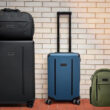Browsing Category
Flashlights
459 posts
Upgrade Your Everyday With This Week’s New EDC Releases
In this roundup, we highlight elevated essentials, exceptional travel gear, and excellent eighth-anniversary flashlight deals. The Brown Buffalo…
Gear Up with Technical Travel Bags and Outdoor Knives In This Week’s New Everyday Carry Releases
In this roundup, we highlight a versatile range of tools and accessories designed to elevate your outdoor adventures…
From Beats to Blades and More in This Week’s Everyday Carry New Releases
From exceptional everyday carry knives to eco-conscious earbuds, we’ve handpicked essentials you won’t want to leave home without…
Vision Takes Center Stage In New Everyday Carry Releases This Week
In this week’s round-up: lights and night vision, an alternative way to cut, and a new daypack contender.…
Wicked Wearables and Tough Tools: New Everyday Carry Gear to Check Out This Week
In this week’s round-up: From compact flashlights to durable backpacks and stylish pilot watches, this week’s lineup is…
From Ink Trails to Flashlight Beams and Sharp Ideas: Check Out This Week’s New Everyday Carry Releases
In this week’s round-up: Tactile Turn releases their icy seasonal pen, aroundsquare’s January drop includes an “anti puzzle,”…
Sleek Slicers, Retro Cans, and Futuristic Flashlights: This Week’s New Everyday Carry Releases
In this week’s round-up, Master and Dynamic MH40 wireless headphones get a Huckberry-exclusive makeover, Vosteed’s Chipmunk is an…
Shine Bright, Cut Right, Store Safe: The Week’s Best Everyday Carry Gear
Flashlights, pocket knives, and robust organization take center stage in this week’s roundup. IMALENT MS32, the New World’s…
Nitecore's New EDC33 is a Throwback and a Leap Forward for Tactical Flashlights
December 15, 2023: Nitecore, one of the leading flashlight manufacturers on the market with a deep and robust…
The Drop: RovyVon S21 Micro-arc Oxidation Rechargeable Flashlight
It’s a big EDC market out there, and tons of awesome gear is released all the time. We…
The Drop: Nitecore NU11 Clip-On Cap Light
It’s a big EDC market out there, and tons of awesome gear is released all the time. We…
The Drop: Ledlenser HF6R Work Headlamp
It’s a big EDC market out there, and tons of awesome gear is released all the time. We…
Olight OClip Flashlight
“Olight’s little clip-on light offers versatile mounting options. Its durable, spring-loaded clip has been tested through 10,000 cycles…
Trending: Fenix E12 V2.0 AA Flashlight
If you are looking for a compact EDC flashlight that’s still powerful enough to cover your bases, the…
The Drop: LOOP GEAR SK03 AA Flashlight
It’s a big EDC market out there, and tons of awesome gear is released all the time. We…
Nitecore LR70 Flashlight + Lantern Combo
“The Nitecore LR70 combines a bright flashlight, a camping lantern, and a power bank. Its flashlight cranks out…
The Drop: AceBeam Terminator M1 Dual Head Flashlight
It’s a big EDC market out there, and tons of awesome gear is released all the time. We…
The Drop: Nitecore MH12 Pro Rechargeable Flashlight
It’s a big EDC market out there, and tons of awesome gear is released all the time. We…
Ledlenser ML4 Mini Lantern
“This teensy lantern from Ledlenser measures less than 4″ tall but produces up to 300 lumens of glare-free…























